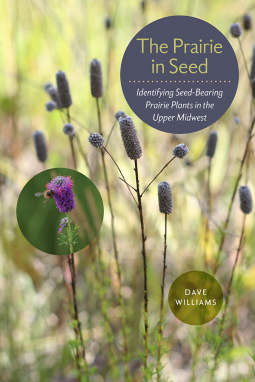
The Prairie in Seed
Identifying Seed-Bearing Prairie Plants in the Upper Midwest
by Dave Williams
This title was previously available on NetGalley and is now archived.
Buy on Amazon
Buy on BN.com
Buy on Bookshop.org
*This page contains affiliate links, so we may earn a small commission when you make a purchase through links on our site at no additional cost to you.
Send NetGalley books directly to your Kindle or Kindle app
1
To read on a Kindle or Kindle app, please add kindle@netgalley.com as an approved email address to receive files in your Amazon account. Click here for step-by-step instructions.
2
Also find your Kindle email address within your Amazon account, and enter it here.
Pub Date Apr 01 2016 | Archive Date Jun 23 2016
University of Iowa Press | Bur Oak Guide
Description
The tallgrass prairie offers solutions to the many environmental challenges facing our water, soils, and ecosystems. Planting prairie on just 10 percent of a field can effectively remove excess phosphorous and nitrogen from the remaining 90 percent. Deep prairie roots and dense aboveground growth filter and hold soils, keeping them from eroding into our streams and rivers. Plants such as common milkweed are the key to the monarch butterfly's recovery. In light of these benefits, perhaps our love affair with European turf grass is slowly giving way to an appreciation of the beauty of our original native prairie.
As interest in these wildflowers and grasses has grown, so has demand for better resources to identify the hundreds of species that make up the native prairie. In The Prairie in Seed, Dave Williams shows us how to identify wildflowers when they are out of bloom and, in particular, how to harvest their seeds. Without the flower color and shape as guides, it can be difficult to identify prairie plants. Imagine trying to distinguish between a simple prairie sunflower and an ox-eye sunflower with no flowers to look at!
In this richly illustrated guide, Williams offers dormant plant identification information, seed descriptions, and advice on seed harvesting and cleaning for seventy-three of the most common wildflowers found in the tallgrass prairie. He includes photographs and descriptions of the plants in bloom and in seed to assist in finding them when you are ready to harvest. Each species description explains where the seeds are located on the plant, when seed ripening begins, and how many seeds each species produces, along with a photograph and approximate measurements of the actual seed. Finally, this guide provides assistance on how and when to hand-harvest seeds for each species, as well as some simple tips on seed cleaning.
An indispensable guide for anyone involved in prairie restoration or conservation, this book is the perfect complement to Williams's The Tallgrass Prairie Center Guide to Seed and Seedling Identification in the Upper Midwest.
As interest in these wildflowers and grasses has grown, so has demand for better resources to identify the hundreds of species that make up the native prairie. In The Prairie in Seed, Dave Williams shows us how to identify wildflowers when they are out of bloom and, in particular, how to harvest their seeds. Without the flower color and shape as guides, it can be difficult to identify prairie plants. Imagine trying to distinguish between a simple prairie sunflower and an ox-eye sunflower with no flowers to look at!
In this richly illustrated guide, Williams offers dormant plant identification information, seed descriptions, and advice on seed harvesting and cleaning for seventy-three of the most common wildflowers found in the tallgrass prairie. He includes photographs and descriptions of the plants in bloom and in seed to assist in finding them when you are ready to harvest. Each species description explains where the seeds are located on the plant, when seed ripening begins, and how many seeds each species produces, along with a photograph and approximate measurements of the actual seed. Finally, this guide provides assistance on how and when to hand-harvest seeds for each species, as well as some simple tips on seed cleaning.
An indispensable guide for anyone involved in prairie restoration or conservation, this book is the perfect complement to Williams's The Tallgrass Prairie Center Guide to Seed and Seedling Identification in the Upper Midwest.
Advance Praise
“Many can identify prairie wildflowers in bloom, but not as readily in fruit or seed. This field guide is a must for those desiring to become more familiar with prairie plants or collecting seed for prairie restorations or reconstructions.”—Daryl D. Smith, coauthor, The Tallgrass Prairie Center Guide to Prairie Restoration in the Upper Midwest
Available Editions
| EDITION | Paperback |
| ISBN | 9781609384098 |
| PRICE | $17.00 (USD) |
Links
Featured Reviews
 Nancy C, Librarian
Nancy C, Librarian
Fantastic photos. Complete descriptions. Great reference for all plant lovers. Full of all the information our ancestors knew and we've not retained.
 Bookseller 198421
Bookseller 198421
Although necessarily a US based book (particularly geared to the Upper Midwest), this Brit found it a fascinating read with much to apply to the UK eco-system. Furthermore, last season I applied Prairie planting to my garden and found this book immensely informative and practically useful on a personal level. Prairie planting is becoming popular around the world right now both for it's beauty and it's eco-principles, and so I would recommend this to anyone.



